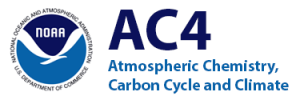- Year Funded: 2017
- Principal Investigators: Bowman, Kevin (Jet Propulsion Laboratory)
- Programs: AC4 Funded Project
- FIREX
- Google Scholar Link
Biomass burning exerts a powerful influence across the entire Earth System, impacting biogeochemical cycles including the carbon cycle, air quality, and climate [Bowman et al, 2009]. Ozone represents an important product of biomass burning and couples several elements of the Earth System. Ozone degrades human health, is a phytotoxin that undermines carbon uptake, and directly forces the climate system through absorption of thermal radiation [e.g., Ainsworth et al, 2012, Bowman and Henze, 2012, Jerrett et al, 2013]. The Regional and Global Environments Experiment (FIREX) will use a variety of ground, mobile, aircraft, and chambers studies to understand the role of biomass burning on atmospheric composition. As part of the AC4 solicitation, we propose to exploit multiple data sets – in situ, remote, and satellite, and especially ozone and CO from the CrIS instrument within an assimilation framework to provide the synoptic and inter annual context for the FIREX campaign.
We propose innovative joint tropospheric ozone products from combining CrIS thermal IR and OMPS UV radiances as well as their assimilation within a nested global to regional air quality modeling system that will quantify the impact of emissions from fires and their chemical transformation on regional and continental air quality before and during the NOAA FIREX campaign. This joint product is a critically important to meet the scientific objectives of AC4 and FIREX. The spectral resolution of infrared hyperspectral CrIS measurements restricts the sensitivity of inferred ozone to the upper troposphere. OMPS measurements are designed for total column ozone only. The team has demonstrated that the combination of radiances from these two instruments has the sensitivity to separate lower and upper tropospheric ozone. This sensitivity permits quantification of ozone in the outflow regions of biomass burning. We will compare these retrieved ozone profiles with the NOAA operational CrIS/ATMS NUCAPS retrieval algorithm, as well as the TOAST (http://www.ospo.noaa.gov/Products/atmosphere/etoast/index.html) ozone retrievals, which are derived from CrIS and SBUV/2. The CrIS/OMPS and NUCAPS ozone, along with full spectral resolution CrIS CO retrievals will be assimilated into the RAQMS/GSI analysis/forecast system. We will perform a retrospective analysis for July-September 2015, which has been a historically active fire season in the western US, provide forecast guidance for flight planning during the FIREX campaign, and conduct a post-mission final science synthesis in conjunction with surface and aircraft data to quantify the impact of biomass burning on regional and global atmospheric composition. This proposal directly meets the NOAA NGSP objective :�??Healthy people and communities due to improved air and water quality services�?� as part of a Weather-ready nation by integrating innovative NOAA satellite observations with NOAA assimilation techniques to demonstrate capacity to assess and forecast the impact of western US fires on local and regional air quality and composition.


